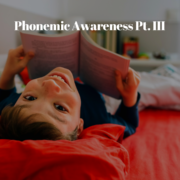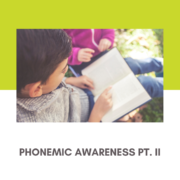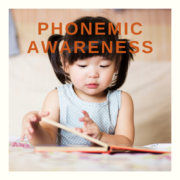Phonemic Awareness Pt. III
Vowel Phonemes
The English alphabet contains the following five vowels: A, E, I, O, U. The letter Y is also considered a vowel when it represents a vowel sound, like “fly” or “lonely.” Vowels make up a small percentage of the letters in the English alphabet; however, the list of vowel sounds that these letters can produce is much longer! Because there are so many different ways of spelling certain vowel phonemes, learning the appropriate patterns for reading and writing require much more instruction than the “sound it out” method.
For instance, take the diphthong (combination of two vowel phonemes) /aɪ/. This sound can be made using multiple different letter patterns:
- eye
- by
- die
- bright
- mite
- Thailand
- kayaks
So how do we begin to teach these phonological skills when there are so many letter combinations to create these sounds?
As discussed in part II, vowel sounds are a whole new ball game when it comes to reading instruction. For beginning readers, as previously explained, it’s all about initially hearing the difference between short and long vowels. Parents and educators can solidify foundational knowledge about how to distinguish short vowel sounds from long vowel sounds by incorporating repetition and movement.
To introduce short vowel sounds, students will want to practice using familiar one-syllable words with corresponding actions. Parents and/or teachers will recite and model the phrase and motion. Then adults should ask children to recite/perform it back in unison:
- “i as in itch” (scratch shoulder)
- “eh as in elephant” (pretend your arm/wrist is the elephant’s trunk)
- “ah as in apple” (motion as though you’re holding and biting into an apple)
- “uh as in up” (jump or point upwards)
- “o (aw) as in octopus” (motion with fingers as though you’re an octopus crawling on the seafloor)
In order to introduce long vowel sounds, repeat the phrase, “Long (fill in with vowel) says its name.” This way, children will begin to equate the words that they are hearing to either long or short sounds. This differentiation prepares them for the spelling patterns/rules that correspond to short and long vowel sounds, which they will learn shortly. Examples include:
- “The word be is a long vowel sound because long E says its name.”
- “The word tape is a long vowel sound because long A says its name.”
- “The word oval is a long vowel sound because long O says its name.”
After children grasp the concept of how these vowel phonemes sound in different words, they are ready to start looking at the letter/sound combinations (diphthongs) in order to correctly read the various vowel patterns.
Digraphs
Another key concept regarding phonemic awareness is the digraph. A digraph is a combination of two letters that make up one sound. Common digraphs include sh, ch, th, and wh. When introducing these sounds, provide visuals or photo cards to accompany the examples of words with digraphs—the more familiar, the better.
Here, you can return to tapping, finger stretching, etc., but instead of tapping syllables within a word, you’ll ask students to tap for the phonemes that they hear in each word. For example, cat and that are both one syllable words; however, students will notice how that has an additional letter. But instead of students tapping out the “t” and “h” sounds separately, the two are combined to form the one sound, the digraph “th.” So while 3-letter word cat is tapped c-a-t (3 phonemes, 1 syllable), 4-letter word that is also tapped using 3 phonemes: th-a-t.






